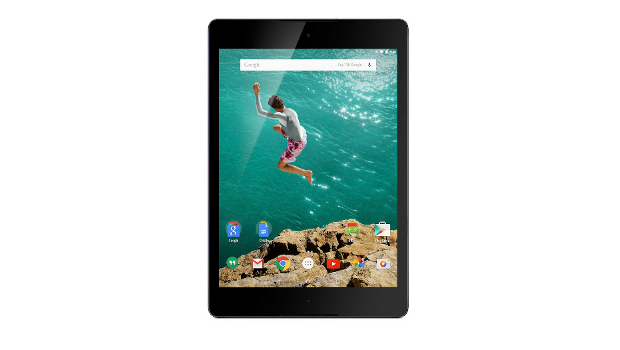We here at TechCentral Towers have always been fans of reference devices. Whether it be the Surface line of tablets, or indeed, the iPad and iPhone families, something that shows off the best a vendor has to offer in terms of its ecosystem can only be a good thing.
And so it is with the Nexus line from Google. The Nexus 9 goes back to manufacturer HTC, the first to produce a Nexus device.
In the past, Nexus devices have usually been a fine balance of cutting edge technology, and solid, reliable performance. The immediate predecessor of the Nexus tablet, the Nexus 7 and 10, were solid performers but never scorching.
The Nexus 9 somewhat diverges from this insofar as it uses the Nvidia 64-bit, dual-core Tegra K1 chipset, backed by 2GB of RAM. The 2.3GHz dual-core processor scores well in the Antutu 5.7.1 benchmark, topping the rankings by a fair margin.
Benchmark
In our testing, a best score of 57860 was achieved, which in context, puts it some way ahead of the Samsung Galaxy Note 4 (sub 50,000). Nexus devices don’t usually do this, and it bodes well for the longevity of the device, as it will not only enjoy the latest and greatest in terms of Android builds, but this raw processing power should allow it to be a decent performer as it does.
The core performance of the device also benefits from Android 5.1.1. In moving to Android Lollipop (5), Google dropped its old Dalvik runtime and implemented Android Runtime (ART).
This is a system where certain key bits of code get converted to native machine code which the device can interpret on installation of an app, as opposed to when it is launched. This gives a significant performance boost for general apps.
In general appearance, the Nexus 9 owes more to its older stablemate, the Nexus 5 from LG. The back is a nice, soft, matte plastic, that is high grip, but alas, attracts quite a few smudge and fingerprint marks. A nice brushed metal aluminium chassis sits between the back and the front, which houses the rocker and power button. There are two microphone holes, one 3.5mm jack and microUSB port for comms and charging.
On the front faced, the forward facing camera is obvious, but other sensors less. A major feature of the Nexus 9 are SoundBoom speakers top and bottom, or left and right in landscape orientation. These give a very good reproduction range and are really quite impressive in the form factor, and price.
Screen time
The screen itself is a multi-touch, IPS LCD capacitive touchscreen, with 16M colours, 226mm (8.9”) across, with a resolution of 1536 x 2048 pixels which gives pixel density of 281 ppi. Overall dimensions are 228.2 x 153.7 x 8 mm, weighing 425g. The battery is 6700 mAh, giving 25 hours of run time.
The screen dimension gives an aspect ratio of 4:3, which is a bit of a departure for a Nexus device, but actually works well for the wider range of activities one might use a tablet for, as opposed to a smart phone.
The rear facing camera is controlled by the Lollipop camera app, and boasts an 8MP sensor (IMX219), with an F/2.4 aperture. The forward facing camera is a 1.6MP (OV9760) job.
The Nexus 9 benefits from a few new things in Lollipop, such as the ‘why didn’t someone think of this before’, screen double tap to wake the device. This, particularly in this form factor, is so much better than fumbling for a button. There is also the possibility to set it to respond to the “OK, Google” declaration even when the screen is blank.
There is also an expanded profiles capability, including better guest access and restricted profiles, but still no automatic child content filtering as seen in Windows 8 — which is a pity.
In use, the Nexus 9 does indeed feel very snappy, loading apps quickly and feeling generally fluid in its presentation and execution. The benefits of the processing power, combined with the ART, obviously showing through. The screen itself is nice, but lacking the vibrancy of certain displays on the market, though this is not necessarily noticeable in standalone use, so not really a criticism as such.
Wi-Fi range
Our test device was the 16GB, Wi-Fi only (though 802.11a/b/g/n/ac), which does highlight another criticism. There is no storage expansion. Now one might counter that with ‘buy the 32GB version’ — which is fair enough. But even on the higher storage versions, you’ll hit a limit long before the useful life of the device. An expansion slot for a microSD card would be a welcome addition. LTE versions are also available, with more storage and a heftier price tag.
In conclusion, the Nexus 9 is a worthy replacement for both the 7 and 9, enjoying as it does extra processing power, high quality audio and excellent connectivity and sensors options. The screen does not so much let it down as not live up to the other specs, but when the price starts from €399, these are not cheap devices, and so expectations are set.
That said, if you are coming from any of its predecessors, this is a worthy upgrade that might displace one or two other devices in the mobile arsenal as well.
Store.google.com/product/Nexus_9
TechCentral Reporters








Subscribers 0
Fans 0
Followers 0
Followers